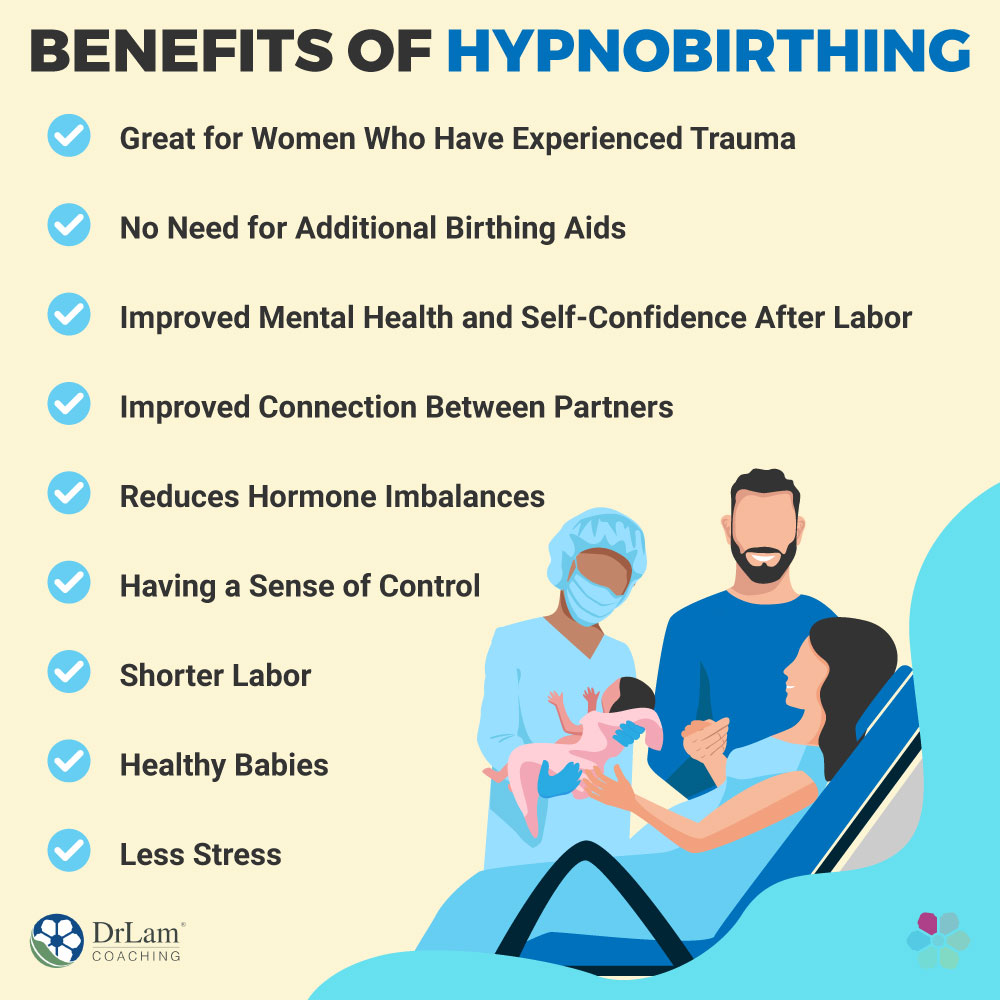 Hypnobirthing is a process that connects the mind and body to combat anxiety, fear, and pain during childbirth. When many women think about giving birth, they are flooded with mental images of pain, distress, and fear. But in truth, the human body is a powerful system that can do so many incredible things.
Hypnobirthing is a process that connects the mind and body to combat anxiety, fear, and pain during childbirth. When many women think about giving birth, they are flooded with mental images of pain, distress, and fear. But in truth, the human body is a powerful system that can do so many incredible things.
From processes like breathing to pushing, every part of childbirth is worthy of study and celebration. Hypnobirthing deals with the power of the mind over what the body is going through during labor and how to encourage the body to relax and go through the process with ease. In this article, you will find everything you need to know about hypnobirthing and how you can use it to have a positive labor experience.
Hypnobirthing was developed by Marie “Mickey” Mongan, a renowned hypnotherapist and Harvard University Ford Foundation fellow. It involves a gentle approach to childbirth, seeking to remove the usual fear and anxiety surrounding the process. Also called the Mongan Method, hypnobirthing teaches expectant mothers that their bodies are built to successfully and positively go through childbirth.
Upon deconstructing the term, it is a build on two words: hypnosis and birthing. The Mongan Method uses specific hypnosis techniques to guide the mother’s brain through labor without pain, fear, or reliance on medication/anesthetics.
Hypnobirthing opens the mother’s mind to new, optimistic possibilities. It encourages a gentle view of childbirth and swaps terms like pain and contractions for more positive terms like pressure, surges, or waves. At its core, hypnobirthing is a powerful tool that essentially reveals the power of teaching the mind to engineer a positive experience when faced with a process that would otherwise be difficult.
This system uses a combination of relaxation and harmonizing techniques, such as deep breathing, visualization, positive prompting from partners, etc. At its core, the main purpose of hypnobirthing is to encourage easy and positive natural birth by helping women deal with any labor-related fears.
In 1944, English obstetrician Grantly Dick-Read published his book, “Childbirth Without Fear.” In this book, Dick-Read defined a common phenomenon associated with childbirth: the Fear-Tension-Pain syndrome, where fear built up from anticipation would lead to a cascade of emotions and physical responses, ultimately causing tension in the mother’s body. The fear and tension then caused labor to be harder, thus resulting in pain.
Dick-Read believed this syndrome caused blood to be drawn away from the primarily involved organs (the uterus) to large muscle groups in the legs. He associated this process with the increased perception of pain during labor.
Mongan draws heavily on Dick-Read’s work, stating that a woman can guide her body into a state of relaxation with the help of hypnosis. This way, her muscles will work in perfect synergy, allowing childbirth to happen painlessly and easily.
Relaxation is the primary aim of hypnobirthing. The concept is based on the idea that a relaxed body and mind work together, not against a natural process. They are thus designed to work better together for a quick and painless birth.
Hypnobirthing is based on the power of suggestion, allowing the woman to encourage and nudge her mind and body into relaxation. The concept employs many hypnosis-related techniques, including the following.
 There is power and a lot of potential in breathing. While many people may not realize it, the secret to many mental and physical challenges we face lies in how we breathe. Particularly during labor, many women take short, shallow breaths into their chests, leaving them feeling even more stressed, tired, and anxious.
There is power and a lot of potential in breathing. While many people may not realize it, the secret to many mental and physical challenges we face lies in how we breathe. Particularly during labor, many women take short, shallow breaths into their chests, leaving them feeling even more stressed, tired, and anxious.
Hypnobirthing includes two breathing techniques that allow mothers to relax and let go of anxiety and tension during labor.
During labor phases where the urge to push is strong, the woman ensures that her muscles are relaxed while creating abdominal pressure. A breathing technique called J-breathing replaces forceful pushing and allows the woman to “breathe out the baby instead.”
For this technique, visualize breathing from your nose and throat into your spine and down into your pelvis through the birth path. This encourages the baby to descend gently through the birth canal with minimal force, minimal tearing, and reduced hyperventilation.
What you assimilate mentally and auditorily plays a significant role in your body’s function and reactions. Focusing only on positive thoughts and words encourages the mind to communicate better with the body, encouraging relaxation and ease. Rather than use otherwise harsh terms like “contraction” to define the tightening of the uterus during labor, women are encouraged to use more positive words like “surge” or “wave.” In reference to membranes, words like “rupture” are replaced with “release.”
In preparation for labor, women are encouraged to affirm positive thoughts about their journey. Rather than think of pregnancy or labor as a difficult or painful process, think of it as a natural process that your body is fully equipped to handle. This can be done with the aid of recorded verbal affirmations that help the mother to enter a state of self-hypnosis and relaxation. There are also many books and videos that represent childbirth as a positive experience.
Many modern-day approaches to birth are harsh and “forceful.” Often focusing on screaming, panic, tears, and forceful contractions, labor can quickly become mentally exhausting before women even reach that point. Hypnobirthing seeks to transform the visual perception of labor, envisioning labor as a calming, gentle, loving, positive experience.
The mother is encouraged to visualize herself as a flower, naturally opening up to relax. In some cases, a birth hypnotherapist may be present during the labor to guide the mother through hypnobirthing. Some women may prepare beforehand, working with hypnotherapists to master self-hypnosis. The woman’s needs and preferences will determine this decision.
According to a comprehensive evaluation of hypnobirthing, many of its techniques were found to improve the experience of giving birth by easing pain and anxiety and increasing a woman's sense of control. With less anxiety, more contentment, fewer labor interventions, more postnatal wellness, and an enhanced birthing experience overall, hypnobirthing improved women's emotional experiences and views on birth.

Hypnobirthing has several advantages over traditional, conventional views on birthing.
 When a woman approaches birth with a sense of tranquility and the idea that she is naturally equipped for it, the process can become significantly easier and quicker. Some research states that hypnosis during labor can help shorten the first stage of childbirth. This stage primarily comprises early and active labor, where contractions become longer, stronger, and rapidly paced as the cervix opens.
When a woman approaches birth with a sense of tranquility and the idea that she is naturally equipped for it, the process can become significantly easier and quicker. Some research states that hypnosis during labor can help shorten the first stage of childbirth. This stage primarily comprises early and active labor, where contractions become longer, stronger, and rapidly paced as the cervix opens.
If a woman is calm and in a state of hypnosis-induced relaxation, interventions such as cesarean deliveries and oxytocin augmentation are often less needed to induce contractions. The woman is in a state of mind where she feels that her body is capable, and it does precisely what it needs to do to bring forth her child.
By controlling her breathing, a woman takes a significant amount of stress off her body and mind. This can be especially helpful if Adrenal Fatigue Syndrome (AFS) is a factor. Adrenal Fatigue Syndrome is a condition born of prolonged stressors, causing the adrenal glands to become fatigued and unable to keep up with the body’s demands for adrenal hormones. Many of these breathing and visualization techniques are helpful throughout pregnancy and even in the postpartum period to help keep stress levels low.
By transforming fear, tension, and pain cascade that Dick-Read described in his work, hypnobirthing can help women achieve med-free labor with manageable pain. This has a lot to do with what we call the NeuroEndoMetabolic (NEM) Stress Response System, particularly the Hormone circuit. This system describes the body’s systemic response to stress and how it ultimately affects various systems throughout the body.
The reproductive system is within the hormonal circuit of the NEM system, meaning that the regulatory functions of the NEM system will be affected by the stress and fear the mother feels. The Hormone circuit involves the thyroid, ovaries, and adrenals, and these other organs produce key hormones for pregnancy and childbirth that share cofactors with the adrenal hormones. This means that stress depletes the building blocks needed to produce hormones like estrogen and progesterone which are key for a healthy pregnancy and postpartum period.
The more stressed the woman feels, especially long term, the more out of sorts these hormones become. By allowing relaxation and mindfulness to take over - as in hypnobirthing - the mother helps her body and the baby go through the process safely and comfortably. This also reduces any related hormone imbalances, making pregnancy and the postpartum period function more smoothly.
This mindset also helps mothers who get epidurals or c-sections. Hypnobirthing is a mindset that can be practiced no matter what type of birth is chosen.
Some research has shown that hypnobirthing techniques help women give birth to stronger, healthier babies per the Apgar scores, a system used to evaluate babies in the first few minutes after they are delivered.
For mothers who have experienced trauma around childbirth or have severe cases of fear and anxiety around the process, hypnobirthing can be an excellent tool for creating a positive experience. It gives additional tools for moving away from these negative experiences. This, in fact, is a major pillar of this concept – eliminating the fear, anxiety, and trauma around childbirth.
 Having a positive, calm, and relaxing birth experience will leave a woman feeling empowered and confident in her body’s abilities. It gives her a sense of control in what could otherwise have been a chaotic and unpleasant experience.
Having a positive, calm, and relaxing birth experience will leave a woman feeling empowered and confident in her body’s abilities. It gives her a sense of control in what could otherwise have been a chaotic and unpleasant experience.
Stress, exhaustion, and postnatal depression can become significant challenges that a woman may face after labor. The lasting effects of hypnobirthing and the techniques employed have been linked to reduced chances of postnatal depression. This process can leave you with better mental health through the early months after your baby arrives. Some of this improved mental health may be related to better hormone balance due to decreased stress levels.
Where partners help each other through the process of hypnobirthing, something else is born of that journey. Many partners report developing a deeper sense of love, respect, and understanding for each other and their child.
Despite having many advantages, hypnobirthing is not a perfect or guaranteed process.
Practicing hypnobirthing is not a guarantee that childbirth will be completely hitch-free or pain-free. While learning to stay relaxed and positive during labor can be tremendously helpful, labor does not always go as planned.
Learning and mastering hypnobirthing will require you to take a course and dedicate time to the practice during pregnancy. Like other concepts, hypnobirthing is more effective when it has been practiced beforehand.
Depending on where you are, you may or may not get access to free hypnobirthing classes. Where they aren’t free, learning this concept will be an additional cost.
Many people say birth is hard, but hypnobirthing says it doesn’t have to be. While hypnobirthing can’t guarantee that you will have the birth experience you want, many women say that it has helped improve their overall birth and pregnancy experience. It also reduces stress through the process, both for you and your baby. Talk to your pregnancy healthcare provider on how to use it to optimize your experience.
If you want to get more info on ways to reduce stress and have a positive relationship with your body, you can reach us at +1 (626) 571-1234 for a free initial consultation with one of our coaches or use our Ask the Doctor system by clicking here.
Hypnobirthing can significantly improve a woman’s approach to childbirth. Using specific calming and positive techniques, hypnobirthing can allow women to have less fear, anxiety, and pain when giving birth. This may reduce tension in the body, which actually increases the sensation of pain. However, it doesn’t completely remove pain or guarantee birth outcomes.
